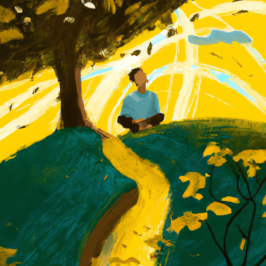
By: Brian Warner
When I was 18, going through depression for the first time, I named it “being angry all the time and not knowing why.”
Then at 21, it was “like my brain won’t stop screaming.”
And at 22, “a rope tied around my heart, with a rock tied around the other end.”
This wasn’t to explain it in as flowery a way as I could. Our emotions are hard to understand. Not just because it can sometimes feel like they come from out of nowhere like Linda Blair getting possessed in The Exorcist, but because what we’re going through isn’t always as simple as “happy” and “sad.” “Happy” can be confident, or inspired, or valued, or free, and “sad” can be remorseful, or defeated, or purposeless, or powerless. Every little thing around and inside us can add up to a different feeling.
And as we try our best to unravel that with our therapists, we gain more perspective on what that feeling really is and slowly become able to put it into words. Naming our emotions is like being in a police procedural – zoom in, enhance, and aha! That scary thing looming over us suddenly isn’t so scary when we can identify it.
Psychiatrist and mindfulness expert Dr. Dan Siegel calls this, “Name it to tame it.” Saying to yourself, out loud, the negative emotion you identify can help to separate yourself from it a little. It doesn’t mean that we shouldn’t feel our emotions or that they’re not valid responses, but that it can help to get some space – like a hand in front of our eyes, it’s easier to see clearly when we create a little distance.
And this soothing feeling isn’t all in your head. Using neuroimaging technology, UCLA researchers scanned the brains of participants as they processed their emotions and talked them out, just like someone would talk to their therapist (minus the fMRI probably). The researchers found that the parts of the brain that add to our emotional state, like the amygdala, were soothed until they became less and less active and people could calm themselves down.
We’ve seen plenty of this in the past few years. In the spring of 2021, as COVID-fatigue was starting to set in amid even the most stringent maskers among us, The New York Times declared that “languishing” was the emotion of the year. Not sadness, not depression, not even more specific emotions like grief or dismay, but “languishing.” ”Somewhat joyless and aimless… A sense of stagnation and emptiness.”
Yep. That about sums up the early months of 2021.
In his piece for The New York Times, Adam Grant wrote,
Part of the danger is that when you’re languishing, you might not notice the dulling of delight or the dwindling of drive. You don’t catch yourself slipping slowly into solitude; you’re indifferent to your indifference. When you can’t see your own suffering, you don’t seek help or even do much to help yourself.
Some people even go a step past finding the right emotional state. In an article for Australia’s Special Broadcasting Service, Carolyn Tate recounts her experience with generalized anxiety disorder. Rather than calling it “a gnawing feeling” or “a sinking feeling” or any other description we might associate with anxiety, she bestowed it with a name: Clive. Clive the Anxiety Monster. And she found that (no offense to all of the Clives out there) it suddenly became harder to take “him” so seriously with a name like that (honestly Clives, I’m sure you’re all wonderful).
Tate had inadvertently stumbled upon a therapy tool called cognitive defusion. When dealing with a difficult emotion, like anxiety, cognitive defusion helps us become aware of our thinking around an issue so we can externalize it, rather than feel like we are the issue.
In other words, “rather than being anxious, Clive has allowed me to recognize that I have anxiety and that anxiety is separate from me. It has helped me divorce myself from a situation that was overwhelming and consuming, and allows me to see that there is a me with and without anxiety.”
Naming our emotions is tough. Not just because it takes so much internal work to understand what it is we should be naming them, but, in an ongoing way, setting and keeping those boundaries with ourselves. Remembering that just because the Clives of the world scream at us or pull us down, they’re not smarter or stronger or more insightful thoughts just because they’re mean to us. Creating that distance, we can see that most of us are doing our best through mental illnesses and emotional trials, and put ourselves in a better position to ask for help.
DISCLAIMER
The information, including but not limited to, text, graphics, images and other material contained on this website are for informational purposes only. No material on this site is intended to be a substitute for professional medical advice, diagnosis, or treatment. Always seek the advice of your physician or other qualified healthcare provider with any questions you may have regarding a medical condition or treatment and before undertaking a new health care regimen, and never disregard professional medical advice or delay in seeking it because of something you have read on this website.






